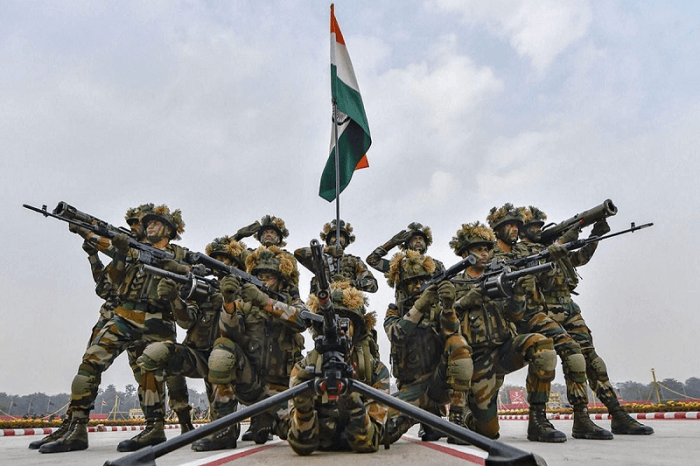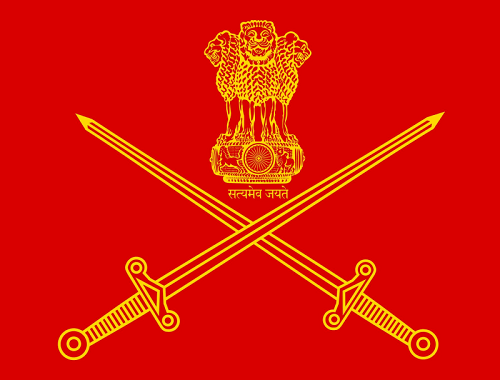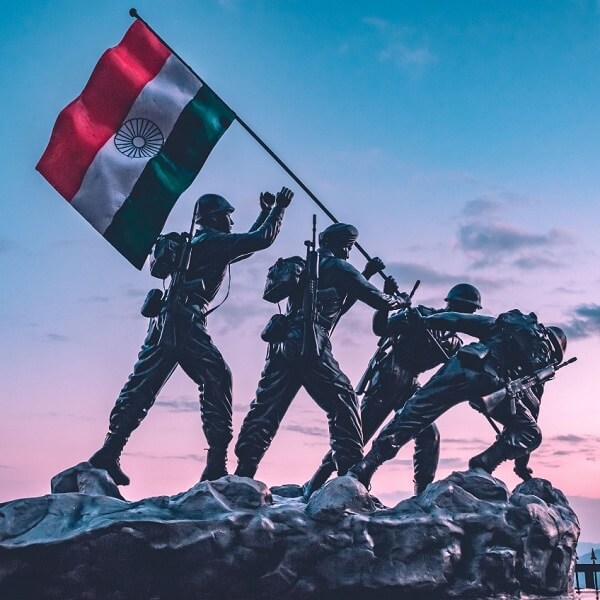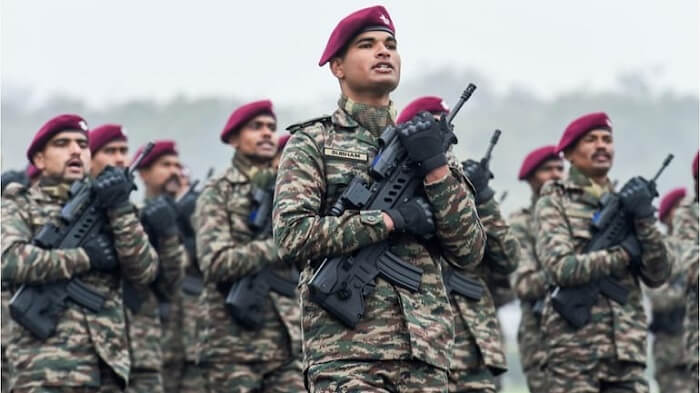Essay on Indian ArmyWe sleep comfortably in our homes because we know that even if we are not alert, there are some people who are always aware so that we can be safe. These people are part of the country's Army. Likewise, the Indian Army is known all over the world for its strength, which is dedicated to protecting Indians from dangers. It was known as British Indian Army prior to 1947 (before India's Independence). The British Indian Army was founded on April 01, 1895, along with the East India Company's presidency army. However, the Indian Army was later included in the presidency army in 1903. At that time, the princely states had their armies, which then got merged into the national Army after the liberation. In India, the Army got formerly established on January 26, 1950, which was the first Republic Day. Its colour, gold, red and black, depicts its great strength in itself. "Service Before Self", translated in Hindi as "???? ???? ????:", is the sole motto of this force. It is at present headquartered in the Integrated Defence Headquarters at the Ministry of Defence, New Delhi. 
OrganizationThe Indian President is the Supreme ordering officer, i.e. Commander-in-Chief, of the Indian Army. At present (2022), the Commander-in-Chief of the Army is Shrimati Draupadi Murmu. However, both the chairs, such as the Chief of Defence Staff (CDS) and the Chairman of the Chief of Staff Committee (CCSC), are vacant. General Manoj Pande, PVSM, AVSM, VSM, ADC is the present Chief of the Army Staff (COAS), whereas the Vice Chief of the Army Staff (VCOAS) is Lieutenant General B. S. Raju, UYSM, AVSM, YSM, VSM. Some of the other recognized and notable commanders who helped raise India with pride through their work towards the country are General K. S. Thimayya, DSO; Field Marshal Sam Manekshaw, MC; Field Marshal K. M. Cariappa, OBE; and others. 
Awards and BraveryThe bravery displayed by the soldiers on the war field is recognized by awarding the soldiers. The awards are distributed by the President of India. Some notable awards or honours include Param Vir Chakra, Maha Vir Chakra, Ashoka Chakra, Kirti Chakra, Shaurya Chakra and Vir Chakra. These awards are given based on individuals' bravery in showing gratitude. Many of the Indian Army personnel have been awarded these awards. Indian Army and its StrengthThe Indian Army is a group with a large number of members than any other Indian Armed Force. Indian Army is based on land, unlike the Indian Navy and the Indian Air Force, which are based on water and air, respectively. The ranks are mainly carried forward since the Britisher's time. They are General, Field Marshal, Colonel, Lieutenant General, Brigadier, Lieutenant Colonel, Major General, Lieutenant, Major, Captain, and Officer Cadet. The Indian army officers are assessed for promotions and appointments through different merit-based training courses. Promotions to and equivalent to lieutenant colonel are based upon service period, whereas those of colonel rank and above depend on selection and promotion to colonel. DivisionIndian Army is divided into seven command regions, basic field formation being a division. Under these divisions lies the regiment, which is permanent in nature. Each regiment is responsible for the recruitment and training of its soldiers. Each of the units and regiment of the Indian Army has its own history and achievements, within and outside of India, before 1947. More than 80% of the active defence officers are in the Army, which is an all-volunteer force. Being one of the largest standing armies in the world, the Indian Army has 960,000 reserve troops and 1,237,117 active troops, according to reports. At present, the Ministry of Defence is looking forward to the infantry modernization program of the Army, which is popularly known as the Futuristic Infantry Soldier As System (F-INSAS). It is also enhancing and obtaining newer assets for its artillery, armoured and aviation branches. Past of the Indian ArmyLet us have a quick look at the brief history of the Army since its formation. As already said, it was unified as the Indian Army by the Britishers in 1885. Till then, it was under their command as their Presidency army. However, the Military Department was created by the East India Company's government earlier in 1776 itself. The military department in the East India Company kept records of the orders issued to the Army by various departments of governance. The Britishers said the Army to be "the force recruited locally and permanently based in India, together with its expatriate British officers". The British Army units which were posted in India for a tour of duty were known as British Army in India. In contrast, the Army of India was said to be the combined force of the Indian Army and British Army in India. The organization was designed in such a way that its main priority was to maintain the supremacy of the British Empire worldwide. That Army not only kept looking at the internal security of the British Rule but also fought many wars, such as the First Anglo-Sikh wars; the Second Anglo-Sikh wars; Anglo-Burmese Wars for control over North-east India; the First opium war with China, the Second Opium war with China along with France, the Boxer Rebellion in China; First Anglo-Afghan war in Britishers and Kabul; Second Anglo-Afghan war in which Britishers started the war with Afghanistan; and Third Anglo-Afghan war in which Afghanistan invaded British India and the World Wars. After 1947, four out of ten Gurkha Regiments were sent to the British Army, and the rest Indian Army was divided into India and Pakistan. A Punjab Boundary Force was formed to help the police of Punjab during the partition, and later, it got disbanded. The departure of all the Britishers after independence replaced the higher ranks with the Indian officers, such as S. M. Shrinagesh, who was a major general and went on to become the third Chief of Army Staff (COAS). Similarly, Gopal Gurunath Bewoor was a colonel and became the ninth COAS; Lieutenant General K. P. Candeth was a brigadier. The officers commissioned by Viceroy were given Junior Commissioned officers posts, while the officers designated by the King were given Indian Commissioned Officers positions. This all happened in the April of 1948. Every year on 15 January, India celebrates its Army Day. This day marks the takeover of Lieutenant General K. M. Cariappa as the first commander-in-chief of the Indian Army in 1949. The last English commander-in-chief of India was General Sir Francis Butcher, and Cariappa's tenure was posted with effect from the first Republic Day. Engagements of the Indian ArmyThe first priority of the Indian Army is to cater for the security of the nation, its unity and integrity, defence from any kind of external aggression and internal threats, and to keep peace and security within the borders. The Army also manages rescue missions at the time of natural disasters, calamities or any other disturbances, displaying their humanitarian face. Some of the major wars and engagements involving the Indian Army are as follows - 2020-2022 China-India issue, 2020-2021 India-Pakistan border issue, 2019 India-Pakistan border issue, 2016-2018 India-Pakistan border issue, 2016 Indian Line of Control strike, 2014-2015 India-Pakistan border issue, 2013 India-Pakistan border issue, 2011 India-Pakistan border issue, 2008 Indo-Pakistani standoff, 2001-2002 India-Pakistan standoff, Kargil War, Siachen conflict, Indo-Pakistani War of 1971, Indo-Pakistani War of 1965, Nathu La and Cho La clashes, Sino-Indian War of 1962, Second Kashmir War, Annexation of Goa, and First Kashmir War. 
The tensions between India and Pakistan were initiated immediately post-partition. The conflict was on the inheritance of the Kashmir region, which was then a princely state with a Hindu ruler and a Muslim population. It resulted in three full-fledged wars in India and Pakistan. Pakistan was invaded in October 1947. The ruler of Kashmir signed the Instrument of Accession after asking for help from India, and the Indian troops began their work there. After that, the Indian Army stopped Pakistan troops at what is now called the Line of Control (LOC). This conflict is still running on. However, the region was now given the status of state by the Indian government in 2019. Next, there was the annexation of Hyderabad. The Indian Army also played a role in the Hyderabad annexation in 1948. The Nizam surrendered after five days of the fight, and five Indian Army infantry battalions and a one-armed squadron were joined in this operation. Not only in India, but the Indian Army also has an impact worldwide. In the Korean war of 1950-53, the 60th Parachute Field Ambulance was sent to assist the UN troops. However, it was decided not to send any combat forces to the war field earlier. Back in India, the Army initiated Operation Vijay when the government's attempts to negotiate with the Portuguese colonial heads failed. This operation was undertaken to take over the Portuguese colonies of Goa, Daman, and Diu in 1961 and establish Indian rule. A dispute on the sovereign status of the Aksai Chin and Arunachal Pradesh border regions led to a war between India and China. China claimed the inheritance of the Aksai Chin region and also constructed the road, which triggered the war. Often small-scale clashes break out in both sides' forces due to the disputed McMahon line. China's suspicion of India's presence in Tibet also led to such clashes. The false belief of the Pakistani leaders of India, still coming up from the effects of the Sino-Indian War, led the Indian Army into the India and Pakistan war of 1965. In fact, India was better in the war with its strategic and tactical terms, but the fight was announced to be inconclusive. It was again on the issue of Kashmir's inheritance. Pakistan initiated it, which tried to trigger an anti-India movement in Jammu and Kashmir. Tashkent Declaration gave out the decision to return to the pre-war positions. India was then into back-to-back wars with its neighbours. Now, it was the Sino - Indian conflict. The Chinese Army was defeated in this scene in Sikkim. With this, the Army did not forget about the internal disturbances. It launched Operation Steeplechase, along with the Indian Police force, para commando brigade, and Indian paramilitary against the Naxals in October 1969. Next, in 1971, the Indian Army lent a helping hand to neighbouring East Pakistan (now called Bangladesh) to get independence from the West Pakistani (now called Pakistan) forces. India gave its full support to the movement. Many Bengali refugees were given shelter, along with military backing. The war of liberation officially ended with the Shimla agreement in 1972. It next was again the conflict between India and Pakistan. Here, the Siachen Glacier was the point of issue. Although it was a part of Kashmir, it was nowhere demarcated on the maps in 1947. The US Army maps depicted the glacier as a part of Pakistan. India initiated Operation Meghdoot, pinched by these developments. Pakistan quickly responded to this, and clashes took place. Indian Army got control of the Sia La and Bilafond La passes, along with the Siachen Glacier. Pakistan attempted to regain power in 1987, 1990, 1995, 1996, and 1999 but was still unsuccessful. For internal harm and the terrorist, too, the Indian Army has played a crucial role. It initiated Operation Blue Star and Operation Woodrose to counter the Sikh insurgents. It helped maintain law and order in Jammu and Kashmir, along with paramilitary forces. As Indian Peace Keeping Forces, a troop was sent to Sri Lanka in 1987. The operation 'Golden Bird' was completed successfully in 1995. One of the most complex and important tests of the Indian Army was the Kargil War. At that time, both countries had recently conducted nuclear tests. In this conflict, the Pakistani paramilitary and the insurgents of the region took control over the deserted strategic heights of the Himalayas, which were to be occupied by Indian forces back in spring. Pakistan supported the troops with arms and supplies. After the Washington Accord, Pakistan agreed to take back its Army. But, some attacks last for a few more days. As the war ended, India had control over the territory, as settled in the 1972 Shimla Agreement. In 2016, India launched Surgical Strike on the terrorists' launch pads in Pakistan-occupied Kashmir in response to the attack made by Pakistani militants on an Indian army base near Uri. The Indian Army is also part of many of the United Nations peacekeeping missions, so far 43. There are many rescue operations taken by the Indian Army, such as the operation Surya Hope. Not only had this, on request of the government, the Indian Army also intervened to cope with any internal threat. Some of the significant operations run by the Indian Army include Operation Meghdoot, Operation Cactus, and Operation Vijay. Many peace exercises have also been held by the Indian Army, such as the exercise Shoorveer and the operation Brasstacks. Many peacekeeping missions of the United Nations, such as those in Angola, Cambodia, Congo, Cyprus, El Salvador, Lebanon, Liberia, Mozambique, Namibia, Somalia, South Sudan, and Vietnam, have seen the Indian Army as its primary component. Major Exercises
Various field formations include the Command, Corps, Division, Brigade, Battalion, Battery, Platoon, and Section. Service in the Indian Army is voluntary in nature. Operation Brasstacks was launched in 1986 to simulate a full-fledged war-like situation on the western border of India. It was the largest ever exercise conducted in India. The exercise Nomadic Elephant has been done with the Mongolian Army since 2004 to enrich counter-insurgency and counter-terrorism operations. The exercise Ashwamedha tests the Army's warfare abilities. Also, the exercise Yudh Abhyas has taken place with the US and Indian Army since 2005. Similarly, the exercise Shakti since 2011, exercise Shoorveer since 2012, Exercise Rudra Akrosh, and Exercise Shatrujeet have also been performed to develop more confidence and new tactics in the Indian Army. ConclusionEach country has its own Army to help defend the nation from external threats along its borders. However, it also aids in many other functions internally and externally. Although different countries have different uniforms, equipment, and tactics, the primary purpose of each country's Army (or military) is to protect its people. Similarly, the Indian Army is dedicated to protecting Indians and their freedom and establishing peace in the nation.
Next TopicEssay on Mango
|
 For Videos Join Our Youtube Channel: Join Now
For Videos Join Our Youtube Channel: Join Now
Feedback
- Send your Feedback to [email protected]
Help Others, Please Share










